Abstract
The effects in mice of administration of the anticonvulsants, progabide, sodium valproate, diazepam, carbamazepine and phenytoin on 5-hydroxytryptophan (5-HTP)-induced head-twitch, apomorphine-induced locomotion, clonidine-induced sedation, and beta-adrenoceptor and 5-HT2 receptor number have been examined. Repeated progabide administration (400 mg kg-1, i.p. twice daily for 14 days) enhanced the head-twitch response the effect lasting for over 8 days after the last dose, and also increased 5-HT2 receptor number in frontal cortex. Progabide (400 mg kg-1, i.p.) enhanced the head-twitch response when given once daily for 10 days and when given intermittently (5 times over 10 days) but not after 1 day of administration. Repeated Na valproate (400 mg kg-1, i.p.) also increased the 5-HTP-induced head-twitch response and 5-HT2 receptor number in the frontal cortex when given twice daily for 14 days, but no behavioural enhancement was seen after 10 days' treatment. Diazepam (1.25 mg kg-1, i.p.) twice daily for 14 days increased the head-twitch response and 5-HT2 receptor number. Repeated progabide and valproate (but not diazepam) administration attenuated the sedation response to the alpha 2-adrenoceptor agonist, clonidine (0.15 mg kg-1) but neither drug altered beta-adrenoceptor number in the cerebral cortex. No changes in apomorphine-induced locomotor behaviour were seen after progabide, valproate or diazepam. Repeated carbamazepine (20 mg kg-1) or phenytoin (40 mg kg-1) administration failed to alter any of the biochemical or behavioural parameters listed above. Like repeated electroconvulsive shock (ECS), progabide altered the head-twitch response, clonidine-induced sedation response and 5-HT2 receptor number. Unlike repeated ECS, it did not alter beta-adrenoceptor number or the apomorphine-induced locomotor response. These data suggest that ECS may produce some changes in monoamine function by altering GABA metabolism as has previously been postulated.
Full text
PDF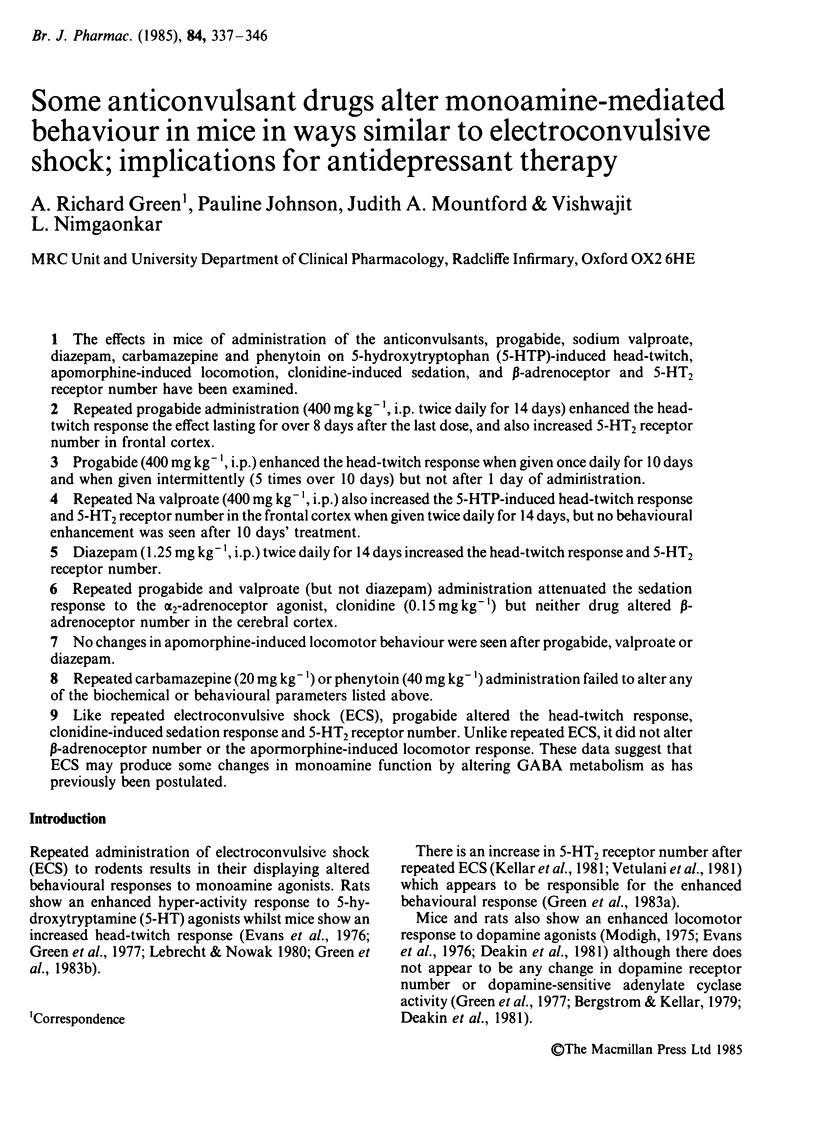
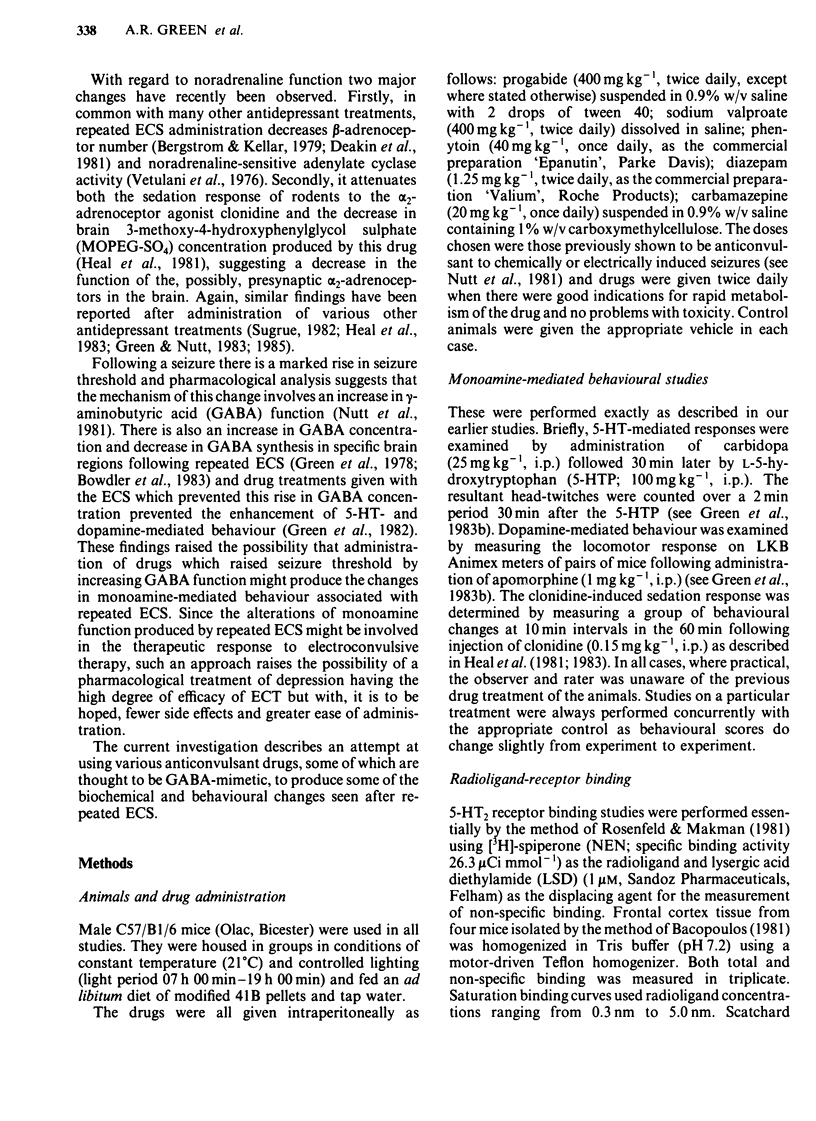
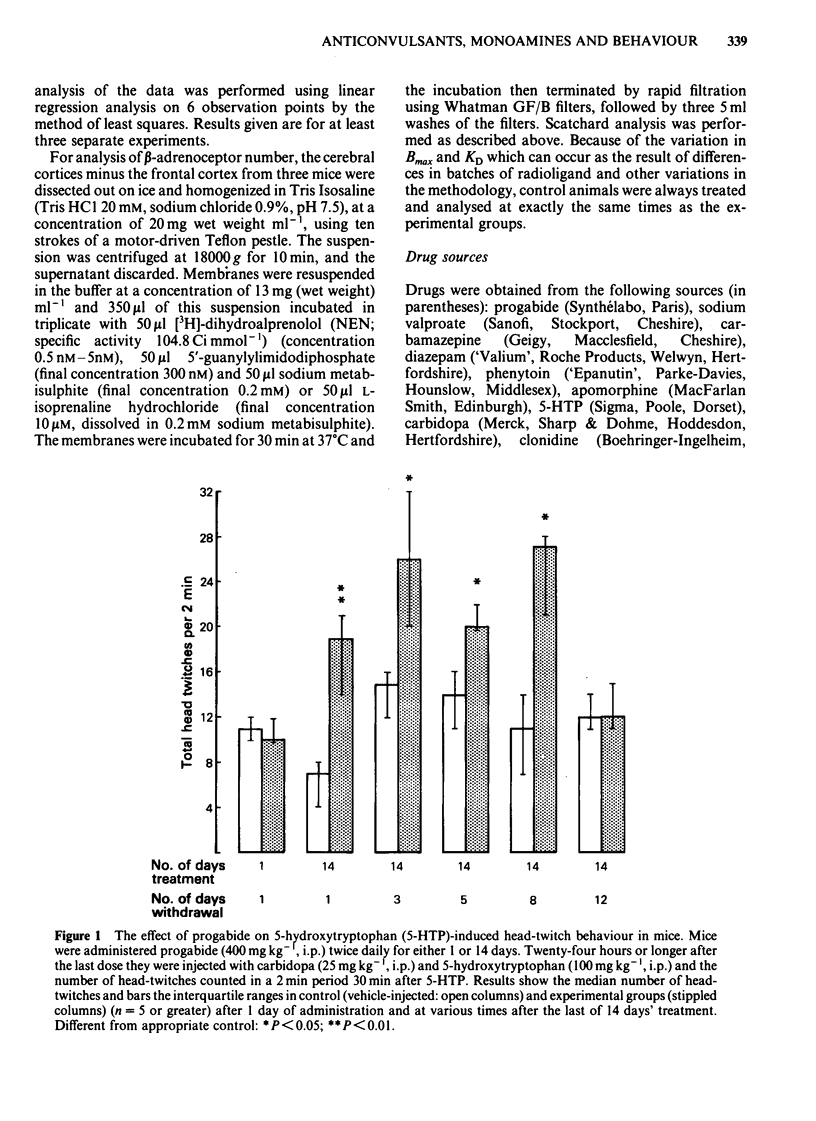
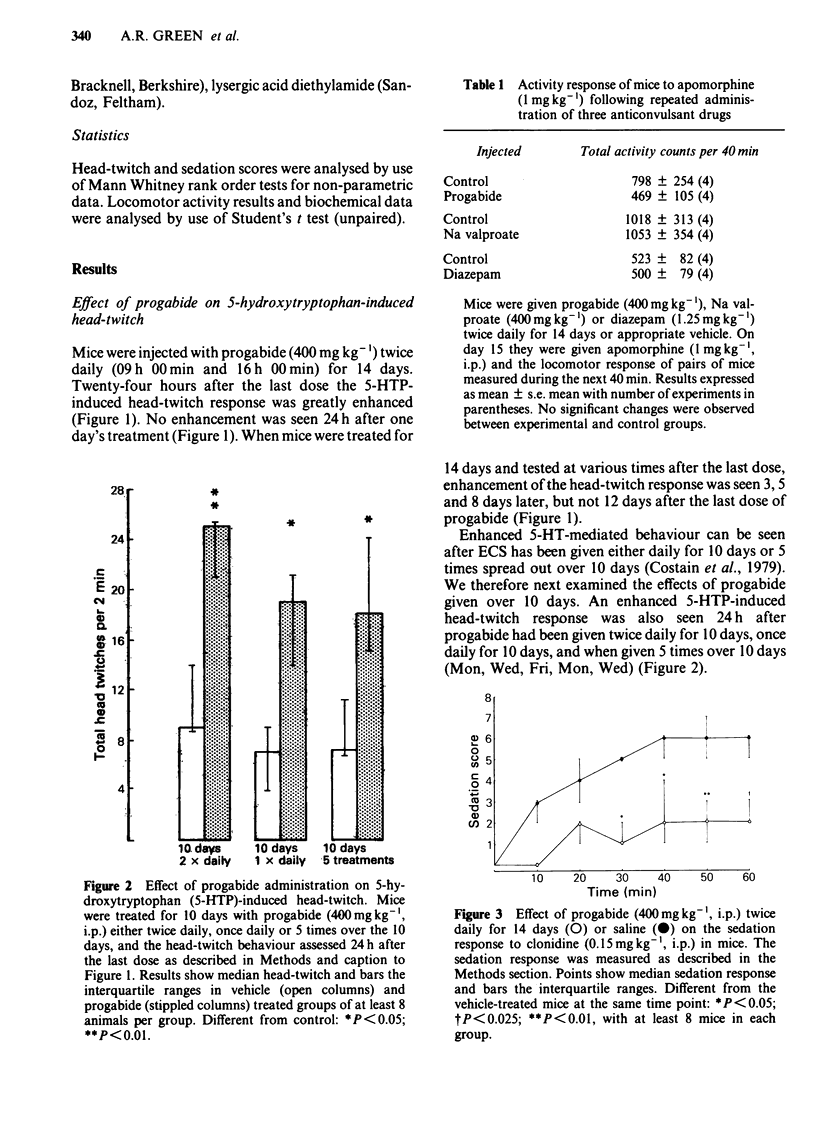
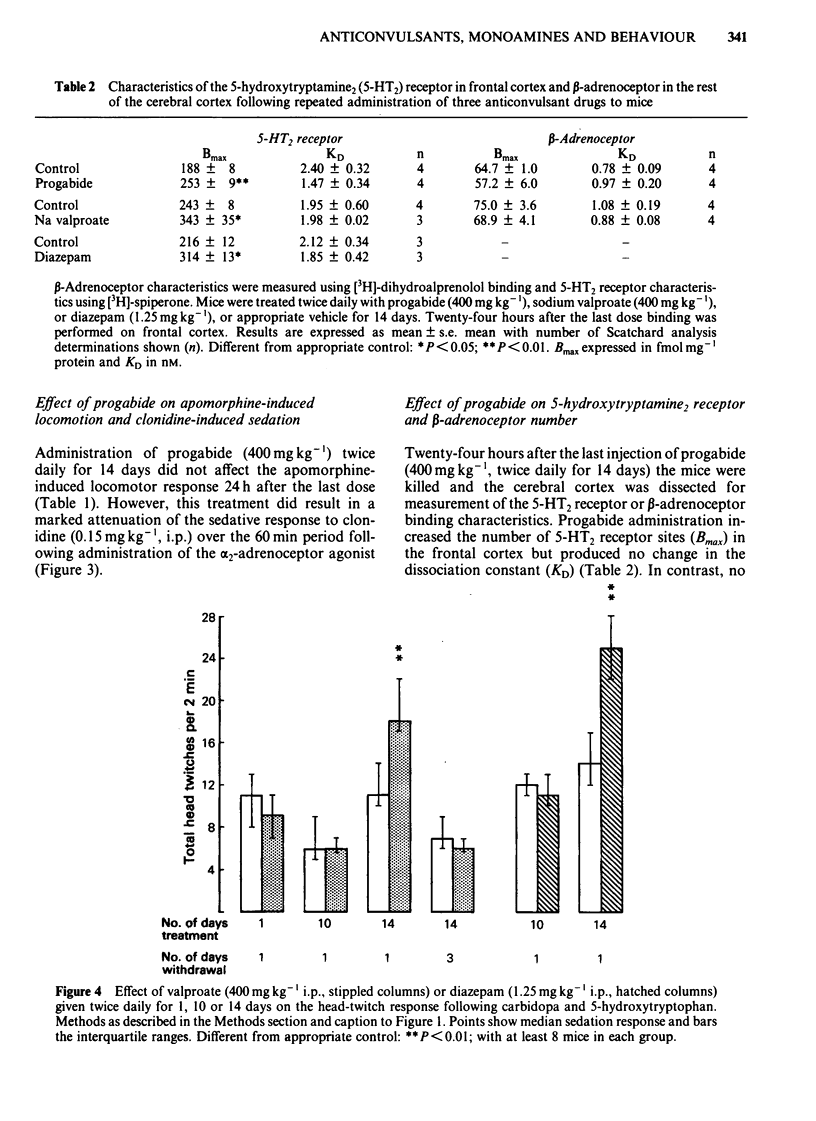
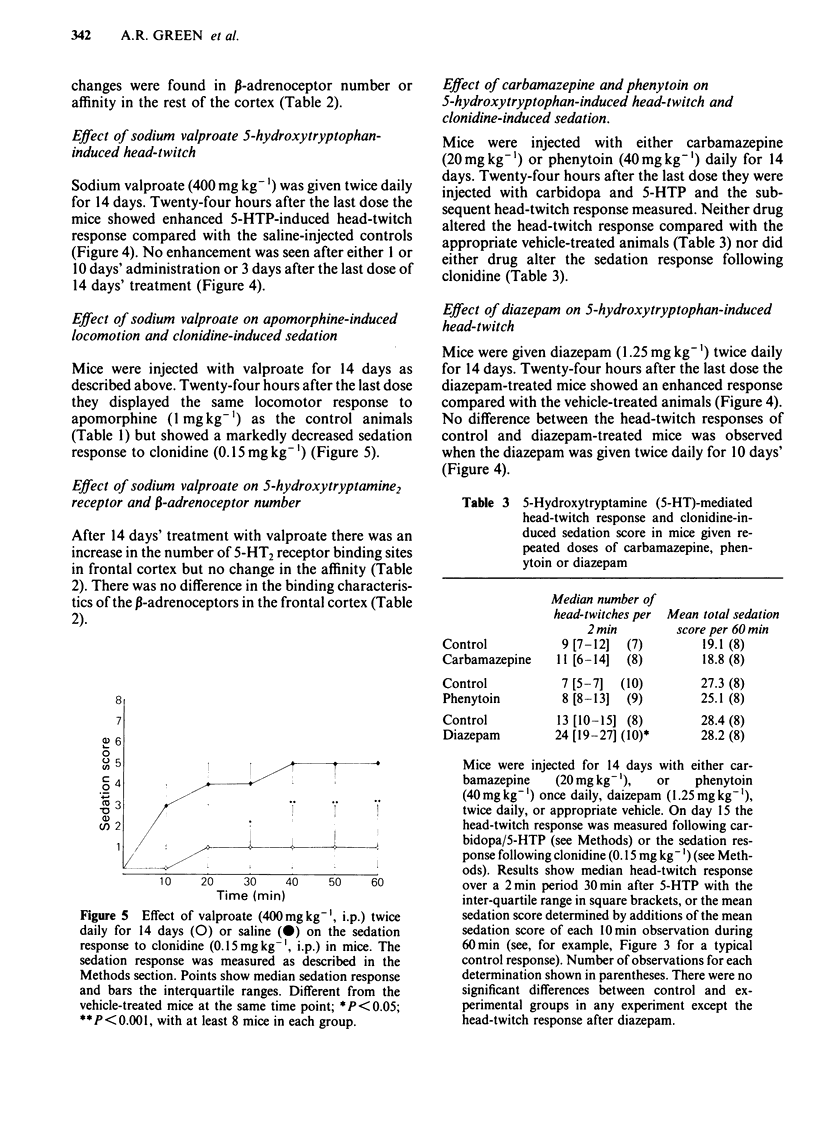
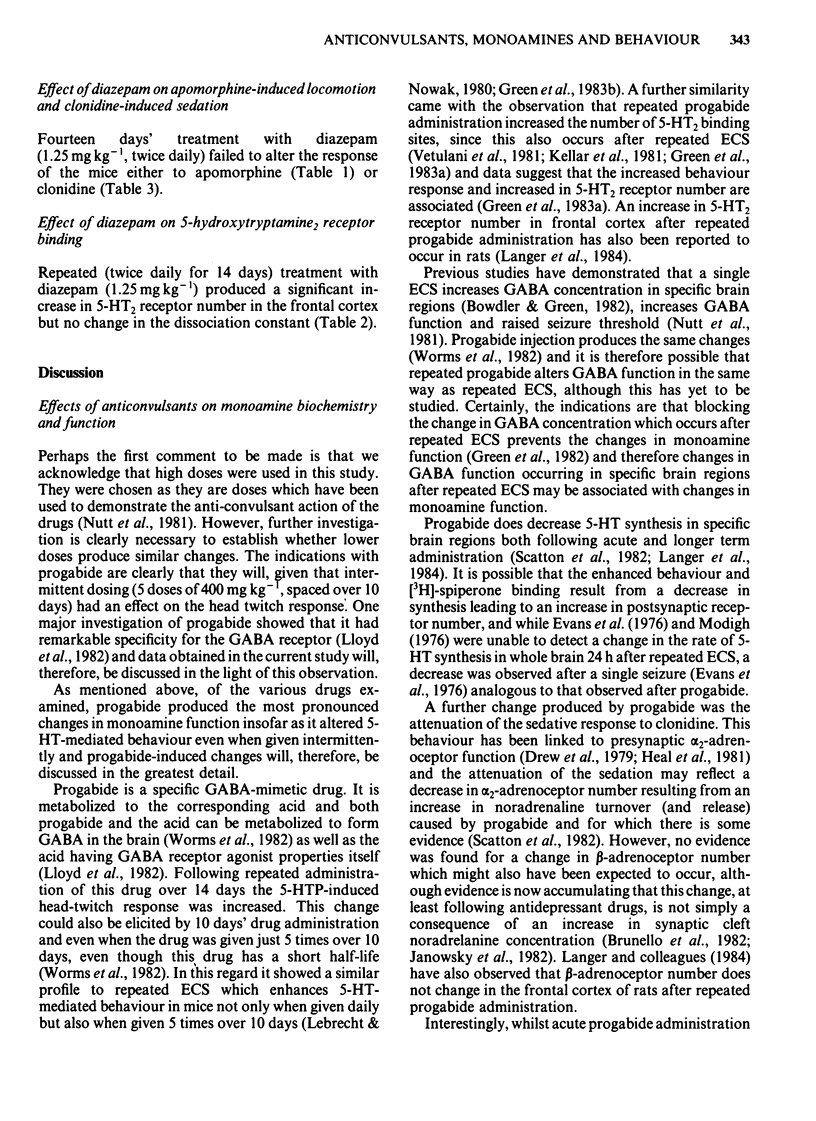
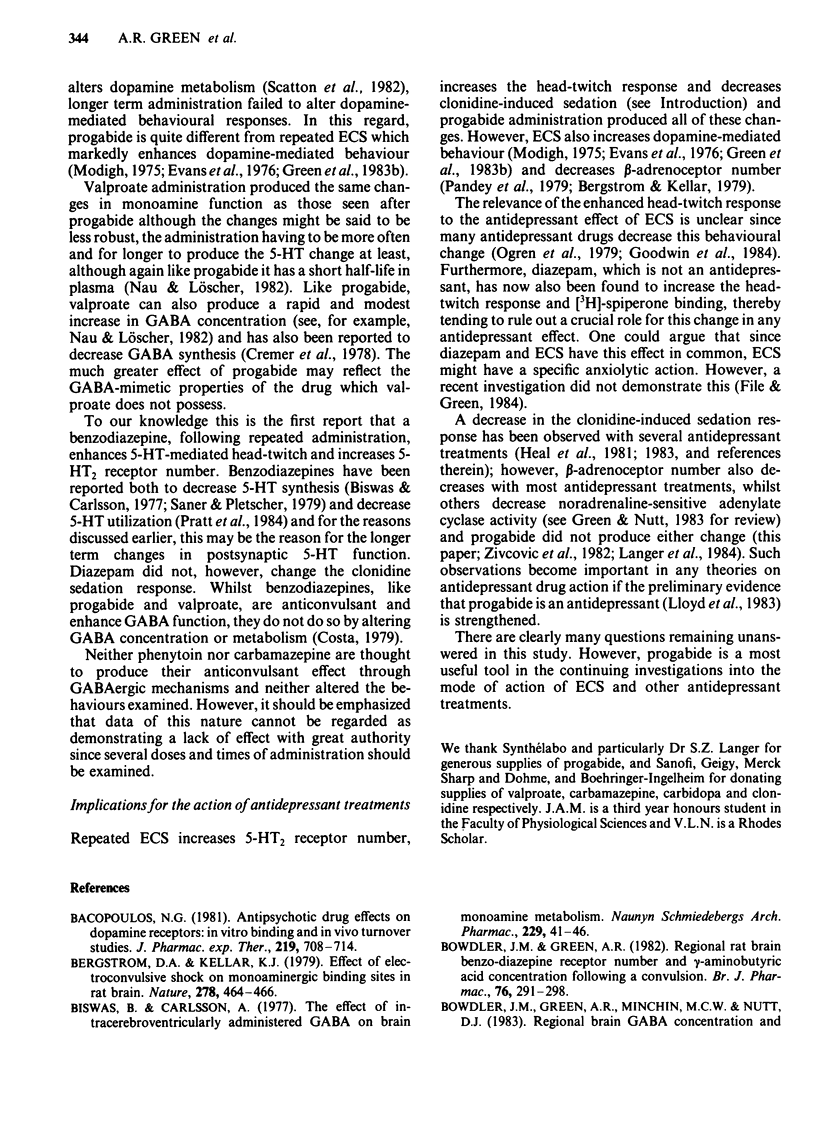
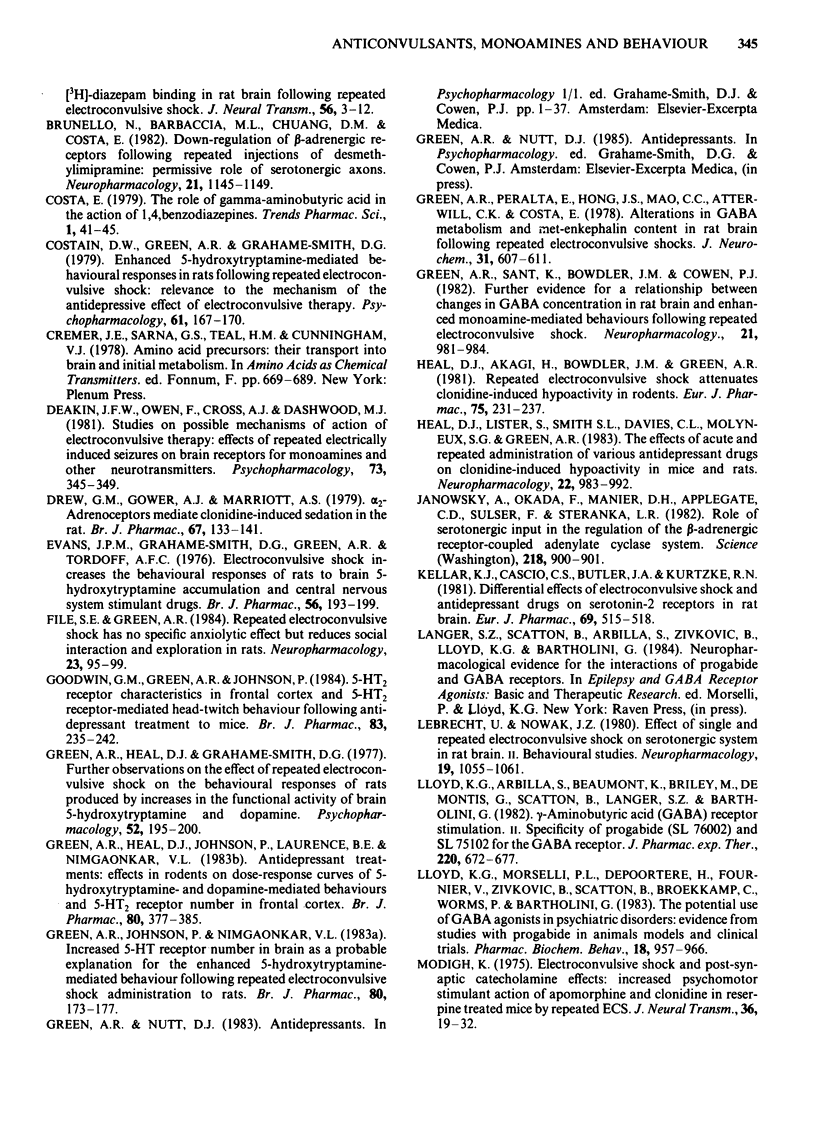
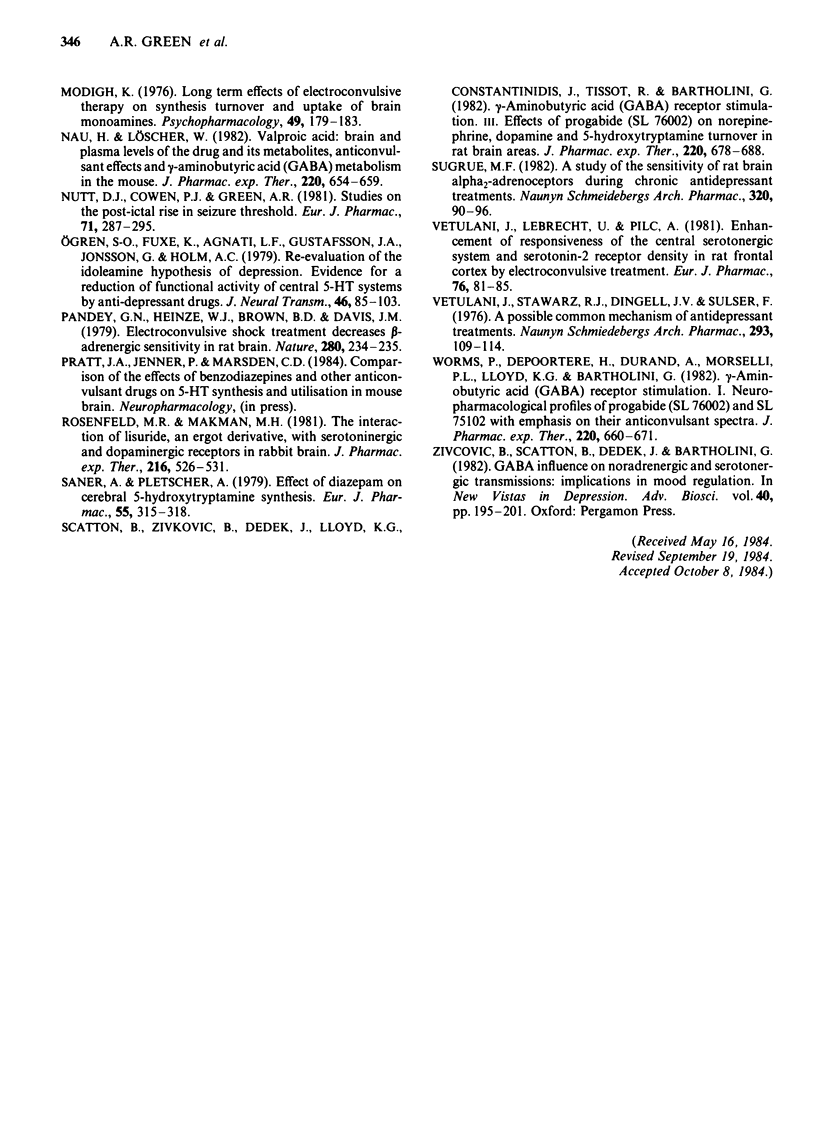
Selected References
These references are in PubMed. This may not be the complete list of references from this article.
- Bacopoulos N. G. Antipsychotic drug effects on dopamine and serotonin receptors: in vitro binding and in vivo turnover studies. J Pharmacol Exp Ther. 1981 Dec;219(3):708–714. [PubMed] [Google Scholar]
- Bergstrom D. A., Kellar K. J. Effect of electroconvulsive shock on monoaminergic receptor binding sites in rat brain. Nature. 1979 Mar 29;278(5703):464–466. doi: 10.1038/278464a0. [DOI] [PubMed] [Google Scholar]
- Biswas B., Carlsson A. The effect of intracerebroventricularly administered GABA on brain monoamine metabolism. Naunyn Schmiedebergs Arch Pharmacol. 1977 Aug;299(1):41–46. doi: 10.1007/BF00508635. [DOI] [PubMed] [Google Scholar]
- Bowdler J. M., Green A. R., Minchin M. C., Nutt D. J. Regional GABA concentration and [3H]-diazepam binding in rat brain following repeated electroconvulsive shock. J Neural Transm. 1983;56(1):3–12. doi: 10.1007/BF01243369. [DOI] [PubMed] [Google Scholar]
- Bowdler J. M., Green A. R. Regional rat brain benzodiazepine receptor number and gamma-aminobutyric acid concentration following a convulsion. Br J Pharmacol. 1982 Jun;76(2):291–298. doi: 10.1111/j.1476-5381.1982.tb09219.x. [DOI] [PMC free article] [PubMed] [Google Scholar]
- Brunello N., Barbaccia M. L., Chuang D. M., Costa E. Down-regulation of beta-adrenergic receptors following repeated injections of desmethylimipramine: permissive role of serotonergic axons. Neuropharmacology. 1982 Nov;21(11):1145–1149. doi: 10.1016/0028-3908(82)90172-1. [DOI] [PubMed] [Google Scholar]
- Costain D. W., Green A. R., Grahame-Smith D. G. Enhanced 5-hydroxytryptamine-mediated behavioural responses in rats following repeated electroconvulsive shock: relevance to the mechanism of the antidepressive effect of electroconvulsive therapy. Psychopharmacology (Berl) 1979 Mar 22;61(2):167–170. doi: 10.1007/BF00426732. [DOI] [PubMed] [Google Scholar]
- Deakin J. F., Owen F., Cross A. J., Dashwood M. J. Studies on possible mechanisms of action of electroconvulsive therapy; effects of repeated electrically induced seizures on rat brain receptors for monoamines and other neurotransmitters. Psychopharmacology (Berl) 1981;73(4):345–349. doi: 10.1007/BF00426463. [DOI] [PubMed] [Google Scholar]
- Drew G. M., Gower A. J., Marriott A. S. Alpha 2-adrenoceptors mediate clonidine-induced sedation in the rat. Br J Pharmacol. 1979 Sep;67(1):133–141. [PMC free article] [PubMed] [Google Scholar]
- Evans J. P., Grahame-Smith D. G., Green A. R., Tordoff A. F. Electroconvulsive shock increases the behavioural responses of rats to brain 5-hydroxytryptamine accumulation and central nervous system stimulant drugs. Br J Pharmacol. 1976 Feb;56(2):193–199. doi: 10.1111/j.1476-5381.1976.tb07442.x. [DOI] [PMC free article] [PubMed] [Google Scholar]
- File S. E., Green A. R. Repeated electroconvulsive shock has no specific anxiolytic effect but reduces social interaction and exploration in rats. Neuropharmacology. 1984 Jan;23(1):95–99. doi: 10.1016/0028-3908(84)90223-5. [DOI] [PubMed] [Google Scholar]
- Goodwin G. M., Green A. R., Johnson P. 5-HT2 receptor characteristics in frontal cortex and 5-HT2 receptor-mediated head-twitch behaviour following antidepressant treatment to mice. Br J Pharmacol. 1984 Sep;83(1):235–242. doi: 10.1111/j.1476-5381.1984.tb10140.x. [DOI] [PMC free article] [PubMed] [Google Scholar]
- Green A. R., Heal D. J., Grahame-Smith D. G. Further observations on the effect of repeated electroconvulsive shock on the behavioural responses of rats produced by increases in the functional activity of brain 5-hydroxytryptamine and dopamine. Psychopharmacology (Berl) 1977 Apr 29;52(2):195–200. doi: 10.1007/BF00439110. [DOI] [PubMed] [Google Scholar]
- Green A. R., Heal D. J., Johnson P., Laurence B. E., Nimgaonkar V. L. Antidepressant treatments: effects in rodents on dose-response curves of 5-hydroxytryptamine- and dopamine-mediated behaviours and 5-HT2 receptor number in frontal cortex. Br J Pharmacol. 1983 Oct;80(2):377–385. doi: 10.1111/j.1476-5381.1983.tb10044.x. [DOI] [PMC free article] [PubMed] [Google Scholar]
- Green A. R., Johnson P., Nimgaonkar V. L. Increased 5-HT2 receptor number in brain as a probable explanation for the enhanced 5-hydroxytryptamine-mediated behaviour following repeated electroconvulsive shock administration to rats. Br J Pharmacol. 1983 Sep;80(1):173–177. doi: 10.1111/j.1476-5381.1983.tb11063.x. [DOI] [PMC free article] [PubMed] [Google Scholar]
- Green A. R., Peralta E., Hong J. S., Mao C. C., Atterwill C. K., Costa E. Alterations in GABA metabolism and Met-enkephalin content in rat brain following repeated electroconvulsive shocks. J Neurochem. 1978 Sep;31(3):607–611. doi: 10.1111/j.1471-4159.1978.tb07831.x. [DOI] [PubMed] [Google Scholar]
- Green A. R., Sant K., Bowdler J. M., Cowen P. J. Further evidence for a relationship between changes in GABA concentration in rat brain and enhanced monoamine-mediated behavioural responses following repeated electroconvulsive shock. Neuropharmacology. 1982 Oct;21(10):981–984. doi: 10.1016/0028-3908(82)90110-1. [DOI] [PubMed] [Google Scholar]
- Heal D. J., Akagi H., Bowdler J. M., Green A. R. Repeated electroconvulsive shock attenuates clonidine-induced hypoactivity in rodents. Eur J Pharmacol. 1981 Nov 5;75(4):231–237. doi: 10.1016/0014-2999(81)90549-5. [DOI] [PubMed] [Google Scholar]
- Heal D. J., Lister S., Smith S. L., Davies C. L., Molyneux S. G., Green A. R. The effects of acute and repeated administration of various antidepressant drugs on clonidine-induced hypoactivity in mice and rats. Neuropharmacology. 1983 Aug;22(8):983–992. doi: 10.1016/0028-3908(83)90214-9. [DOI] [PubMed] [Google Scholar]
- Janowsky A., Okada F., Manier D. H., Applegate C. D., Sulser F., Steranka L. R. Role of serotonergic input in the regulation of the beta-adrenergic receptor-coupled adenylate cyclase system. Science. 1982 Nov 26;218(4575):900–901. doi: 10.1126/science.6291152. [DOI] [PubMed] [Google Scholar]
- Kellar K. J., Cascio C. S., Butler J. A., Kurtzke R. N. Differential effects of electroconvulsive shock and antidepressant drugs on serotonin-2 receptors in rat brain. Eur J Pharmacol. 1981 Feb 19;69(4):515–518. doi: 10.1016/0014-2999(81)90460-x. [DOI] [PubMed] [Google Scholar]
- Lebrecht U., Nowak J. Z. Effect of single and repeated electroconvulsive shock on serotonergic system in rat brain--II. Behavioural studies. Neuropharmacology. 1980 Nov;19(11):1055–1061. doi: 10.1016/0028-3908(80)90101-x. [DOI] [PubMed] [Google Scholar]
- Lloyd K. G., Arbilla S., Beaumont K., Briley M., De Montis G., Scatton B., Langer S. Z., Bartholini G. gamma-Aminobutyric acid (GABA) receptor stimulation. II. Specificity of progabide (SL 76002) and SL 75102 for the GABA receptor. J Pharmacol Exp Ther. 1982 Mar;220(3):672–677. [PubMed] [Google Scholar]
- Lloyd K. G., Morselli P. L., Depoortere H., Fournier V., Zivkovic B., Scatton B., Broekkamp C., Worms P., Bartholini G. The potential use of GABA agonists in psychiatric disorders: evidence from studies with progabide in animal models and clinical trials. Pharmacol Biochem Behav. 1983 Jun;18(6):957–966. doi: 10.1016/s0091-3057(83)80021-5. [DOI] [PubMed] [Google Scholar]
- Modigh K. Electroconvulsive shock and postsynaptic catecholamine effects: increased psychomotor stimulant action of apomorphine and clonidine in reserpine pretreated mice by repeated ECS. J Neural Transm. 1975;36(1):19–32. doi: 10.1007/BF01243434. [DOI] [PubMed] [Google Scholar]
- Modigh K. Long-term effects of electroconvulsive shock therapy on synthesis, turnover and uptake of brain monoamines. Psychopharmacology (Berl) 1976 Sep 17;49(2):179–185. doi: 10.1007/BF00427287. [DOI] [PubMed] [Google Scholar]
- Nau H., Löscher W. Valproic acid: brain and plasma levels of the drug and its metabolites, anticonvulsant effects and gamma-aminobutyric acid (GABA) metabolism in the mouse. J Pharmacol Exp Ther. 1982 Mar;220(3):654–659. [PubMed] [Google Scholar]
- Nutt D. J., Cowen P. J., Green A. R. Studies on the post-ictal rise in seizure threshold. Eur J Pharmacol. 1981 May 8;71(2-3):287–295. doi: 10.1016/0014-2999(81)90031-5. [DOI] [PubMed] [Google Scholar]
- Ogren S. O., Fuxe K., Agnati L. F., Gustafsson J. A., Jonsson G., Holm A. C. Reevaluation of the indoleamine hypothesis of depression. Evidence for a reduction of functional activity of central 5-HT systems by antidepressant drugs. J Neural Transm. 1979;46(2):85–103. doi: 10.1007/BF01250331. [DOI] [PubMed] [Google Scholar]
- Pandey G. N., Heinze W. J., Brown B. D., Davis J. M. Electroconvulsive shock treatment decrease beta-adrenergic receptor sensitivity in rat brain. Nature. 1979 Jul 19;280(5719):234–235. doi: 10.1038/280234a0. [DOI] [PubMed] [Google Scholar]
- Rosenfeld M. R., Makman M. H. The interaction of lisuride, an ergot derivative, with serotonergic and dopaminergic receptors in rabbit brain. J Pharmacol Exp Ther. 1981 Mar;216(3):526–531. [PubMed] [Google Scholar]
- Saner A., Pletscher A. Effect of diazepam on cerebral 5-hydroxytryptamine synthesis. Eur J Pharmacol. 1979 May 1;55(3):315–318. doi: 10.1016/0014-2999(79)90200-0. [DOI] [PubMed] [Google Scholar]
- Scatton B., Zivkovic B., Dedek J., Lloyd K. G., Constantinidis J., Tissot R., Bartholini G. gamma-Aminobutyric acid (GABA) receptor stimulation. III. Effect of progabide (SL 76002) on norepinephrine, dopamine and 5-hydroxytryptamine turnover in rat brain areas. J Pharmacol Exp Ther. 1982 Mar;220(3):678–688. [PubMed] [Google Scholar]
- Sugrue M. F. A study of the sensitivity of rat brain alpha 2-adrenoceptors during chronic antidepressant treatments. Naunyn Schmiedebergs Arch Pharmacol. 1982 Aug;320(2):90–96. doi: 10.1007/BF00506306. [DOI] [PubMed] [Google Scholar]
- Vetulani J., Lebrecht U., Pilc A. Enhancement of responsiveness of the central serotonergic system and serotonin-2 receptor density in rat frontal cortex by electroconvulsive treatment. Eur J Pharmacol. 1981 Nov 19;76(1):81–85. doi: 10.1016/0014-2999(81)90012-1. [DOI] [PubMed] [Google Scholar]
- Vetulani J., Stawarz R. J., Dingell J. V., Sulser F. A possible common mechanism of action of antidepressant treatments: reduction in the sensitivity of the noradrenergic cyclic AMP gererating system in the rat limbic forebrain. Naunyn Schmiedebergs Arch Pharmacol. 1976 May;293(2):109–114. doi: 10.1007/BF00499215. [DOI] [PubMed] [Google Scholar]
- Worms P., Depoortere H., Durand A., Morselli P. L., Lloyd K. G., Bartholini G. gamma-Aminobutyric acid (GABA) receptor stimulation. I. Neuropharmacological profiles of progabide (SL 76002) and SL 75102, with emphasis on their anticonvulsant spectra. J Pharmacol Exp Ther. 1982 Mar;220(3):660–671. [PubMed] [Google Scholar]


